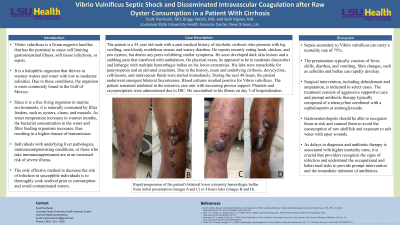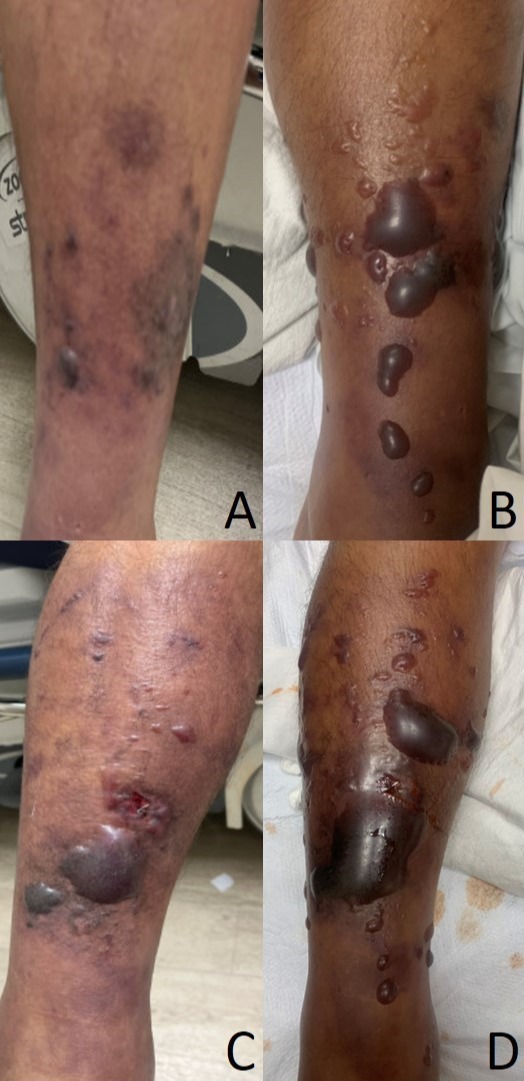Tuesday Poster Session
Category: Liver
P4009 - Vibrio Vulnificus Septic Shock and Disseminated Intravascular Coagulation After Raw Oyster Consumption in a Patient With Cirrhosis
Tuesday, October 24, 2023
10:30 AM - 4:00 PM PT
Location: Exhibit Hall

Has Audio

Scott R. Piechocki, MD, MS
Louisiana State University Health Sciences Center
New Orleans, LA
Presenting Author(s)
Scott R. Piechocki, MD, MS1, Briggs Welch, MD1, Seth Vignes, MD2
1Louisiana State University Health Sciences Center, New Orleans, LA; 2LSU Health Sciences Center, New Orleans, LA
Introduction: Vibrio vulnificus is a pathogen that can cause gastroenteritis, soft tissue infections, and sepsis. It’s a halophilic organism that thrives in warmer waters with low to moderate salinities. Due to these conditions, it’s commonly found in the Gulf of Mexico. It is a free living organism that is naturally consumed by filter feeders, such as oysters. Individuals with underlying liver disease or immunocompromising conditions are at an increased risk of severe illness. Here, we present a fatal case of Vibrio vulnificus septic shock and disseminated intravascular coagulation (DIC) in a patient with cirrhosis.
Case Description/Methods: The patient is a 54-year-old male with a past medical history of alcoholic cirrhosis who presents with leg swelling, watery diarrhea, and nonbloody, nonbilious emesis. He reports recently eating lamb, chicken, and raw oysters, but denies any peers exhibiting similar symptoms. He soon developed dark skin lesions and a stabbing pain that interfered with ambulation. On physical exam, he appeared to be in moderate discomfort and lethargic with multiple hemorrhagic bullae on his lower extremities (images A and C). His labs were remarkable for pancytopenia and an elevated creatinine. Doxycycline, ceftriaxone, and intravenous fluids were started immediately due to the recent shellfish ingestion and concerning exam. During the next 48 hours, the patient underwent emergent bilateral fasciotomies. Blood cultures resulted positive for Vibrio vulnificus. The patient remained intubated in the intensive care unit with increasing pressor support. Platelets and cryoprecipitate were administered due to DIC. He succumbed to his illness on day 3 of hospitalization.
Discussion: Sepsis due to Vibrio vulnificus carries a mortality rate of 75%. The presentation consists of fever, chills, diarrhea, and vomiting. Skin changes, such as cellulitis and bullae, can rapidly develop. Surgical intervention, including debridement and amputation, is indicated in select cases. The treatment consists of aggressive supportive care and prompt antibiotic therapy. Gastroenterologists should be able to recognize those at risk and counsel them to avoid the consumption of raw shellfish and exposure to salt water with open wounds. As delays in diagnosis and antibiotic therapy is associated with higher mortality rates, it is crucial that providers recognize the signs of infection and understand the occupational and behavioral risks to provide prompt intervention and the immediate initiation of antibiotics.

Disclosures:
Scott R. Piechocki, MD, MS1, Briggs Welch, MD1, Seth Vignes, MD2. P4009 - Vibrio Vulnificus Septic Shock and Disseminated Intravascular Coagulation After Raw Oyster Consumption in a Patient With Cirrhosis, ACG 2023 Annual Scientific Meeting Abstracts. Vancouver, BC, Canada: American College of Gastroenterology.
1Louisiana State University Health Sciences Center, New Orleans, LA; 2LSU Health Sciences Center, New Orleans, LA
Introduction: Vibrio vulnificus is a pathogen that can cause gastroenteritis, soft tissue infections, and sepsis. It’s a halophilic organism that thrives in warmer waters with low to moderate salinities. Due to these conditions, it’s commonly found in the Gulf of Mexico. It is a free living organism that is naturally consumed by filter feeders, such as oysters. Individuals with underlying liver disease or immunocompromising conditions are at an increased risk of severe illness. Here, we present a fatal case of Vibrio vulnificus septic shock and disseminated intravascular coagulation (DIC) in a patient with cirrhosis.
Case Description/Methods: The patient is a 54-year-old male with a past medical history of alcoholic cirrhosis who presents with leg swelling, watery diarrhea, and nonbloody, nonbilious emesis. He reports recently eating lamb, chicken, and raw oysters, but denies any peers exhibiting similar symptoms. He soon developed dark skin lesions and a stabbing pain that interfered with ambulation. On physical exam, he appeared to be in moderate discomfort and lethargic with multiple hemorrhagic bullae on his lower extremities (images A and C). His labs were remarkable for pancytopenia and an elevated creatinine. Doxycycline, ceftriaxone, and intravenous fluids were started immediately due to the recent shellfish ingestion and concerning exam. During the next 48 hours, the patient underwent emergent bilateral fasciotomies. Blood cultures resulted positive for Vibrio vulnificus. The patient remained intubated in the intensive care unit with increasing pressor support. Platelets and cryoprecipitate were administered due to DIC. He succumbed to his illness on day 3 of hospitalization.
Discussion: Sepsis due to Vibrio vulnificus carries a mortality rate of 75%. The presentation consists of fever, chills, diarrhea, and vomiting. Skin changes, such as cellulitis and bullae, can rapidly develop. Surgical intervention, including debridement and amputation, is indicated in select cases. The treatment consists of aggressive supportive care and prompt antibiotic therapy. Gastroenterologists should be able to recognize those at risk and counsel them to avoid the consumption of raw shellfish and exposure to salt water with open wounds. As delays in diagnosis and antibiotic therapy is associated with higher mortality rates, it is crucial that providers recognize the signs of infection and understand the occupational and behavioral risks to provide prompt intervention and the immediate initiation of antibiotics.

Figure: Rapid progression of the patient's bilateral lower extremity hemorrhagic bullae from initial presentation (images A and C) to 4 hours later (images B and D).
Disclosures:
Scott Piechocki indicated no relevant financial relationships.
Briggs Welch indicated no relevant financial relationships.
Seth Vignes indicated no relevant financial relationships.
Scott R. Piechocki, MD, MS1, Briggs Welch, MD1, Seth Vignes, MD2. P4009 - Vibrio Vulnificus Septic Shock and Disseminated Intravascular Coagulation After Raw Oyster Consumption in a Patient With Cirrhosis, ACG 2023 Annual Scientific Meeting Abstracts. Vancouver, BC, Canada: American College of Gastroenterology.
